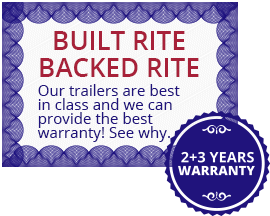Some of you reading this have been hauling boat trailers around for as long as you’ve been driving. You might have started with a small boat trailer for your 14’ foot boat, then over the years slowly worked your way up to a large boat trailer for a boat you want to spend days at a time on. Some of you might even have multiple boat trailers, such as one for your pond boat, one for lakes, and a pontoon trailer for when you want to have a party on the water.
But there are those of you out there looking for your very first boat trailer, and you might never have towed anything in your life. That’s who we’re talking to today, those who might want a few extra tips before they take their boat trailer home for the first time.
Acceleration
When you drive your empty boat trailer home, you might not notice much difference in how much your truck is slowed down. After all, boat trailers themselves aren’t that heavy. But once you get your boat on it, you’re adding a lot of towing weight. Know how your truck and trailer combo work before you start putting yourself in instances when you absolutely have to accelerate quickly.
Slowing Down
Sure, you need to know that it’s going to take longer to get your trailer and boat up to speed, but it’s even more important to know who much longer it’s going to take to get everything to stop. You’ve got a lot of energy built up when you’re speeding down the highway, which means that it’s going to take longer to brake. Make sure to overcompensate on how much braking distance you need, because it’s a lot safer than under-compensating.
It’s also important that you leave more space between you and the vehicles in front of you, because if they slam on their brakes you’ll need that extra space to stop so that you don’t crash into them.
Turning
We’ve all seen “this vehicle makes wide turns” decals on larger vehicles. Well, now you are that vehicle!
Again, overcompensating on a turn usually beats under-compensating, because under-compensating means you’ll be driving the trailer’s wheels up on the curb or clipping a light pole. Remember, the boat is almost always wider than the trailer itself. If you’re not quite getting it and have caused some damage, we’d suggest heading to a parking lot and setting up some cones to practice. There’s no shame in wanting to become a better driver.
Passing
When towing anything, there’s not much of a chance that you’ll be passing someone on a two-lane road. But when you’re on the highway, you might need to get around slower vehicles. Simply remember that you’ll need to compensate for the extra length of your vehicle when you consider the boat trailer. You don’t want to move from the passing lane back to the regular lane before you’ve completely cleared the vehicle you’re passing.
Don’t forget, in most cases you’ll be required to travel at a slower speed, both for legal reasons and due to the manufacturer’s instructions. In most cases you won’t be passing anyone but the slowest of right-hand lane vehicles.
Watch the Wind
When you’re hauling a boat trailer, you’re presenting a much longer vehicle to the wind. Here’s our advice: keep both hands on the steering wheel, because there are times the wind can take you for a ride.
The first type of wind, of course, is the natural wind that occurs when you’re on the highway. It’s tricky because you never know when the next gust is coming, so it might be white-knuckle driving even after you’ve gotten accustomed to driving with your new trailer.
It gets even weirder (if not more predictable) when you’re being passed by a semi-truck. First your trailer will be affected by the high-pressure air in front of the passing truck, pushing it to the right while your own vehicle isn’t affected. After that your vehicle will feel the pressure, leveling everything out. But it’s not over yet, because once the truck passes you the trailer will want to move to the left as it’s sucked into the low-pressure zone, followed by your vehicle as the large truck passes you completely. While you will learn how to accommodate for this situation, the first few times it happens can be quite disconcerting. Again, grab that wheel tight!
Fishtailing
You won’t be surprised to know that one of the most important aspects of designing a trailer is to prevent it from fishtailing. It’s an incredibly dangerous situation, and recovering from it is something that every boat owner should know.
Fishtailing can occur when something shifts your load suddenly, usually because of a huge gust of wind or a sudden jerk of the steering wheel. When this happens, the trailer can start weaving back and forth. The best thing you can do in this situation is to keep your hands steady on the wheel and take your foot off the accelerator. Don’t brake, which can make matters worse. After you’ve come to a halt, check your load to ensure that it hasn’t shifted too much to one side. Evenly distributing the weight is what keeps a load from fishtailing, and remember to always keep your weight toward the front as much as possible.
Learning to drive with a boat trailer can be a challenge, but it’s one that you can quickly get used to. Here at LoadRite Canada, we can help. Just stop by our Innisfil Yard or Monkland locations today!






